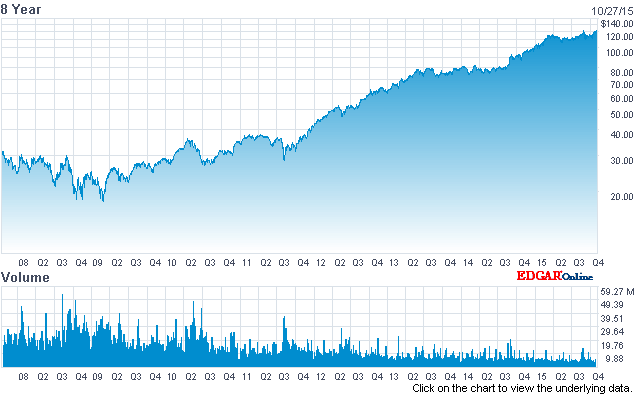Home Depot: More Growth With Existing Resources?
America’s top home improvement retailer, Home Depot (NYSE:HD), has been among the biggest beneficiaries of the U.S. economic recovery, with the stock price growing by over 400% since the recession. This was achieved predominantly through productivity gains, which entailed improving customer satisfaction, optimizing shelf space, and closing non-performing stores, rather than creating new sources of revenues. But, productivity gains have a threshold, beyond which it could become difficult for Home Depot to sustain this growth. In this case, is it time for Home Depot to start finding new sources of revenue? Probably not just yet. Here are a few factors that could support further growth for Home Depot, given existing resources:

Figure 1: Home Depot Stock Quote, NASDAQ
— Top on the list, are macroeconomic fundamentals particularly related to the U.S. economy. Developments in the U.S. economy is important for Home Depot’s success since over 90% of the company’s stores are located in the country. Although the U.S. economy has come a long way since the recession, economic growth has dampened slightly in recent times predominantly because of a strong dollar choking off exports, and slower growth in domestic consumer demand. In spite of this, projections for the U.S. economy continue to remain upbeat, with real GDP expected to sustain growth rates of over 2% in 2015 and 2016, and unemployment rates trending to historic lows of about 5%. Hence, in the larger scheme of things, Home Depot could continue benefiting, especially as Americans with a greater degree of job stability continue to invest in their homes.
- What’s Next For Home Depot Stock After An Upbeat Q3?
- With The Stock Almost Flat This Year, Will Q2 Results Drive Home Depot’s Stock Higher?
- With The Stock Flat This Year, Will Q1 Results Drive Home Depot Stock Higher?
- Down 8% This Year Will Home Depot Stock Rebound After Its Q3?
- Home Depot Stock To See Little Movement Past Q2
- Why Homebuilder Stocks Are Soaring This Year
— Next, while the general events in the U.S. economy are relevant for Home Depot’s success, what is of more relevance are developments in the housing markets, and here is where the real potential for growth lies for the retailer. To see this, let’s look at existing home sales and new home sales figures.
After a softer year in 2014, where existing home sales averaged at ~4.9 million (-2.9% growth year-on-year), the U.S. has seen phenomenal growth so far in 2015, with the metric being recorded at ~5.3 million in Q2 2015. The National Association of Realtors project existing home sales to average out at ~5.28 million (7% increase year-on-year) and ~5.47 million (3.5% increase) in 2015 and 2016, respectively. New home sales have also been undergoing phenomenal growth in the U.S. Although 2014 proved to be a drag even in this area, with the metric advancing just 2.3% in comparison to the 16.3% growth achieved the previous year, the NAR projects growth of a whopping 20.1% and 29.3% going into 2015 and 2016. Even after these projections, existing home sales or new home sales are way off the levels that they were at pre-recession (See Figures), which leaves immense potential to be uncovered. As construction activity picks up, so could home improvement spending. Furthermore, since home improvement demand always occurs at a lag in comparison to developments in the housing markets, Home Depot could see sufficient demand over the next year or two, primarily based on the numbers achieved so far.
— Last, but not the least, while the U.S. economy at large, and housing markets in particular, are indicative of bright prospects for Home Depot, the retailer also has much potential left to be uncovered on the business side of things. This is predominantly in relation to the company’s online sales, which has been undergoing phenomenal growth. In 2014, Home Depot’s online sales increased by over $1 billion, which represented a growth rate of over 36%. However, online sales presently account for a meager 5% of net sales, which leaves significant room for growth. Given that consumers, particularly of the millennial generation, are increasingly relying on online capabilities to fulfil their shopping needs, Home Depot could be presented with a big opportunity in this sphere. In this case, this is not only a matter of garnering customers from arch-rival, Lowe’s (NYSE:LOW), but also from other players such as Amazon and eBay, who offer home improvement products online. Now, since Home Depot offers better interconnectedness between stores and its online platform, apart from offering a wider array of products in the home improvement realm, they could very well enhance their customer base by delving into this space.
In conclusion, Home Depot could be left with considerable room for growth even if they do not look at generating new revenues by means of M&A activity or by geographical expansion. In that, the mere projections for the U.S. economy and housing markets, along with new sales avenues such as the dotcom platform in itself, could present considerable growth opportunities for the retailer.
We have a price estimate of $124 for Home Depot’s stock, which is almost in line with the current market price.
Our complete analysis for Home Depot’s stock
Sources:


